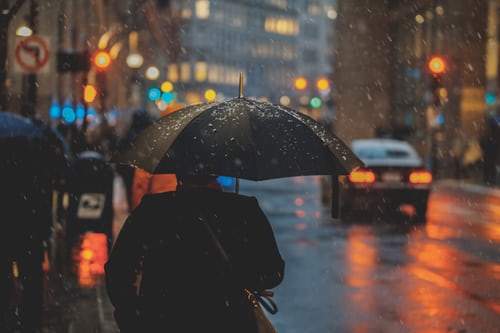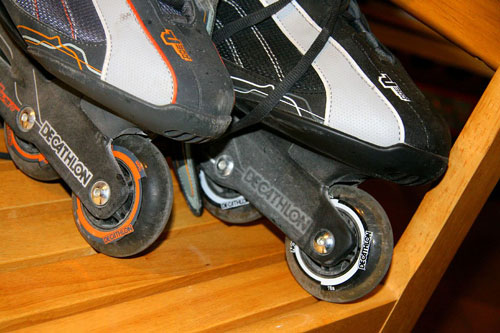Sometimes the urge to skate is overwhelming, or sometimes the weather shifts and you get stuck in a shower. Should you take your skates off immediately or is it fine to carry on?
So, can you inline skate in the rain? You should avoid rollerblading in the rain. It becomes extremely slippery and it takes you longer to stop. Your skates can slip easily in both pushing and when turning, so falls are likely. It also damages your skates, including your bearings. If you have no choice, there are precautions you should take.
So, the question is, what tips are there to help us skate in the rain with (relative) safety…

1. Don’t Ever Skate In The Rain Because of These Basic Reasons…
Damage To Your Skates: Your skates will get damaged by the dirt, grit and grime, especially your bearings. To skate in the rain multiple times will cost you more in terms of maintenance and replacing bearings.
Stopping Is Treacherous: It takes a lot longer to slow down and stop, so skating around other people or traffic is especially dangerous because of the extra time needed to stop.
Surfaces Become Slippery: It’s possible to slip over even going straight on some types of surfaces that become especially slippery, like white lines in the road.
Turning Invites Falls: When you lean into a turn the downward force can cause the skates to slip right from under you.
But… If you absolutely have to rollerblade in the rain here are some tips:
2. Look Out For White Lines And These 3 Dangerous Surfaces
Water fills in the tiny imperfections in the road or pavement and effectively smooths out the surface. This creates less friction when your wheels roll against the ground, making them more likely to slide sideways.
Some surfaces can become particularly dangerous.
Stay away from painted lines like those down a cycle path as your skates can just slide right from under you. Similarly, avoid oily patches in parking spaces, and metal plates and grates. Wet concrete can be extremely slippery.
Paths may sometimes be less oily than the road in the wet. And though wet asphalt might be a good place to learn how to powerslide, it’s advisable to be aware of the dangers of different surfaces before skating across them.
Cobblestones: dangerous. Spread your feet a little to absorb bumps (but you should have your feet closer than normal in the wet anyway – see ‘technique’ section below). Roll at slow speed.
Marbled ground: super dangerous. Don’t push out to the side, just go straight. Don’t turn sharply. Keep body centered.
Autumn leaves: treacherous. They hide holes, sewer grates, branches, rocks, uneven surfaces. The leaves themselves can be slippery. Keep speed controlled, and a stabilised position. If you’ve no other options keep rolling with both feed on ground. Shift your weight from front back a little. Be very careful in leaves when turning.
Roads can still be dirty a couple of days after the rain.
3. Clean Your Bearings Immediately After Skating In The Wet

You’re going to collect a lot of water and mud and grit into the components of your skates in the wet. Aside from the slipperiness of each surface, this is the other main reason why it’s a bad idea to skate in the rain. All that tiny debris and water is going to damage your skates – the water’s going to get past your bearing shields, into your bearings and can cause them to rust within hours, leaving you with ruined, rust-locked bearings.
Everything that is metal will rust (although, maybe not aluminium) – lace eyelets, buckles, axles.
So when you’ve skated in the wet, you have to take apart your skates and clean the components that have been affected by all this dirt and water. Unscrew your wheels and take the bearings out.
Quick guide on washing bearings:
- Unscrew the components
- Wash them with rubbing alcohol to remove the water
- Immediately relube (important because rubbing alcohol will not just remove the water, but the lube that was there too)
Your axles are important here. At the very least you should remove the wheels from the frame, otherwise the bolts, axles, and nuts may rust and freeze together.
If you’re tight for time, the next best thing to is immerse the bearings in oil (even baby oil could work), so that you displace the water from the bearings and keep the bearings from being exposed to air. After being in the oil for a while, you can transfer them into a Ziploc baggie.
A really last resort is to submerse the bearings in water – if you have no better alternative this will at least keep the air out and limit rust from forming. Keep them submerged until you’re ready to clean them. But this is not the best method.
In fact, a better idea is to have a spare pair of “wet bearings” (or even an entirely spare pair of skates for the rain if you can afford it). You will still need to conduct maintenance as outlined above.
Sealed bearings with grease can also be an option for rainy days, but will only help up until a point.
After training let your roller skates air-dry, with crumpled paper inside them.
4. How To Skate In The Wet: Short, Smooth, More Frequent Strides…
Skating in a straight line
With the slippery surfaces your feet can slide away from each other, causing you to stretch out and fall. To prevent this you must keep your feet as close together as possible.
Your ability to push is also reduced in these low friction conditions, so you can try to push down on your skates instead of out. You don’t want to push too far sideways, and you shouldn’t push too strong. With a shorter stride you can go for higher frequency. Your strides should be kept short and smooth.
You will want to keep your weight more centred over the non-stroking skate so if that one slips as you push, you have a better chance of recovering your balance. Push less, keeping your legs in and bending low, taking the corners slow and giving yourself more time to brake.
Skating round bends
Do not take bends like you do in the dry!
Avoid crossing over your skates to go round bends as your skates can slip because you’ve shifted your centre of balance to one side, acting like a lever pushing down on your skates.
When a bend comes up reduce your speed, and take it like a beginner or downhiller. Adopt a neutral position with two feet stable, bending your knees keeping them flexible, maybe even hands at knees. Your centre of gravity should stay low. The half-step technique might help where the inside rolling skate never leaves the ground, the outside one pushes to turn.
It almost goes without saying to not take turns sharply…
Braking on skates in the wet
Every braking method is less efficient in the wet and this is one of the core dangers of skating in the rain. The back wheel is prone to aquaplaning in the wet when using the back brake. This is when a thin layer of water forms between the wheel and the road, meaning a loss of traction.
You need a lower body posture and stronger pressure on the brake.
The trick is to look further ahead and foresee obstacles much before they arrive, because in the wet, a surprise is not a good thing. You need to give yourself longer time to stop.
Going downhill
Test your braking ability early on, slow at the top of the hill before you get too fast, and know that when you add hill + hidden oily zones this is going to be disastrous.
You can adopt the staircase technique if possible, which is to go step by step with the shoes perpendicular to the slope, so the wheels cant roll down the slope easily. Like walking sideways with skis.
Climbing uphill
Again, keep your stride short, the wider stride is a waste of effort. Short, light and fast, and aim for best ground contact.
…
Rain skating uses slightly different muscles than dry skating, putting more of a strain on your adductors. To toughen them up, do some duck walking in your skates (walking with your toes pointed outward).
5. Prepare Your Skates Before Going Out In The Rain
If you’re skates are in terrible condition you need to fix this anyway.
Make sure the bearings are working so the wheels can spin easily.
It’s largerly about your wheels.
The harder your wheels, the less grip you will have. Wheels made from polyurethane rubber can harden in the cold as well. So hard wheels (grade 85A and up) are not advisable. Some manufacturers specialise in good grip wheels, like Labeda and MPC who do specific rain wheels.
Soft wheels have better grip on wet pavement. You can test different wheels out if you want.
So you could get wheels around 70a. This will be worse for speed overall, but better for wet.
For some more information on wheels that work in the rain, here’s Tiago Inline Skater discussing his “rain wheels”.
You can also do stuff to keep your feet dry. Buy boot covers, like those made by Ezeefit, to keep skate boots dry. Of course this will do very little for the wheels.
Related Questions
Skateboarding in light rain? This is also going to be bad for the skateboard including the bearings, and is also treacherous because of how slippery the ground becomes, so should be avoided.
Can outdoor skates be used indoors? Yes outdoor skates can be used indoors. They may be designed for different surfaces, and you will have to check the location to see if they are okay with you doing so, but this should be no problem in most cases.

